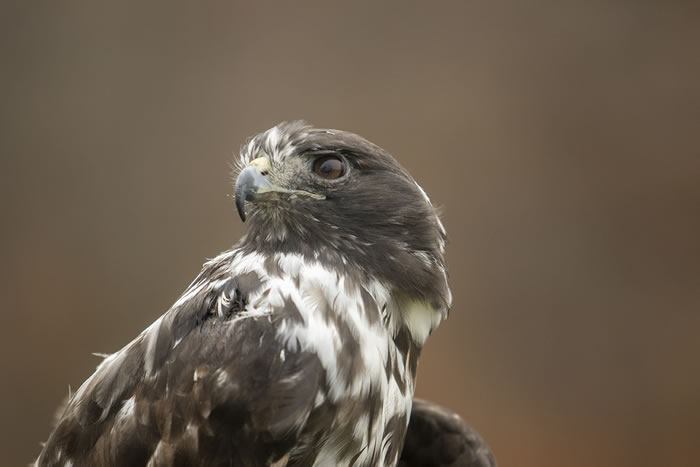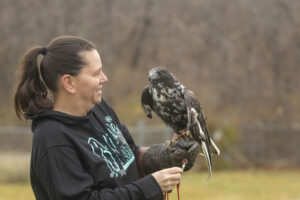Published 1/10/2023
The University of Missouri College of Veterinary Medicine Raptor Rehabilitation Project is tasked with the rehabilitation of hawks, eagles, owls and other raptors that are brought to the facility, with the goal of eventually returning them to the wild. However, there are times when birds are not able to be released due to their condition. That was the case for J.D., a Harlan’s hawk, which is a sub-species of the red tail hawk. A Missouri Department of Conservation agent brought J.D. to Mizzou in 1986 after the hawk was found along a roadside. Lizette Somer, a community volunteer with the Raptor Rehabilitation Project since 2015, says due to the length of time that he was down before being found, his fractures could not fully heal. “Based on the injuries and where he was found, presumably he was hit by a car,” said Somer. “There wasn’t much that could be done with the fractures, so he wasn’t able to heal up appropriately to sustain flight and go back into the wild.”

From that point the project decided to apply for him to become an educational ambassador.
As part of the Raptor Rehab Project, volunteers help raise public awareness for these birds by giving presentations throughout the state, bringing the birds along for the presentations to teach people about the ecological and cultural importance of birds of prey. J.D., who was introduced to the program in 1987, was the first educational ambassador for Mizzou’s Raptor Rehab Project. As of 2018, J.D. was officially retired as an educational ambassador after more than 30 years of service.
Raptor Rehab Project volunteers are not able to identify J.D.’s exact age but know that when he came to the CVM in 1986, he was already through his first year of life. “In the first year of life their tails are striped,” said Somer. “After that first year they get their adult plumage, and it’s a lot more difficult to tell their age. We don’t know his true age, but we know at the time he came to us he was already an adult.”

J.D.’s age is important because Somer and those at the Raptor Rehab Project believe him to be one of the oldest living red tail hawks in captivity. Somer says that in the bird community, it is common to count a bird’s age as another year older on Jan. 1 of each year, because nobody knows when they were hatched. That would mean that J.D. is estimated to be at least 38 years old. After receiving an email from Hawk Watch International, Somer said she was led to believe that J.D. may be the oldest living red tail hawk in captivity, as no others came forward that had an older bird. Though it is not definitive, J.D. is certainly one of the oldest living red tail hawks right now and has far outlived the average life expectancy of red tail hawks in captivity, which is estimated to be 20 years, according to an article from Washington State University.
Since joining the Raptor Rehab Project, Somer has developed a relationship with J.D., as she is charged with taking care of him. “When I started with the project, he was the second education ambassador that I trained with,” said Somer. “I enjoyed working with him because he’s a bird that requires you to be gentle and quiet to work with him, and that tends to fit my personality. He became special to me because I gained his trust, and he was just easy for me to work with.”
J.D.’s health is currently stable, but last year he gave Somer and her fellow volunteers a scare when he fell ill. Somer said she worked closely with his primary veterinary student at the time. “We agreed to take him out of the hospital and bring him down to the rehab facility,” she said. “I did all of his treatments every day, and I just wanted to give him the best we could.”
While J.D. recovered, the volunteers at the Raptor Rehab Project continue to keep a close eye on him. “For his age and for his past injuries he is still very healthy,” said Somer. “His age is definitely very advanced and rather unusual. Similarly, to someone who is in their 90s, every day is a gift.”
By Nick Childress